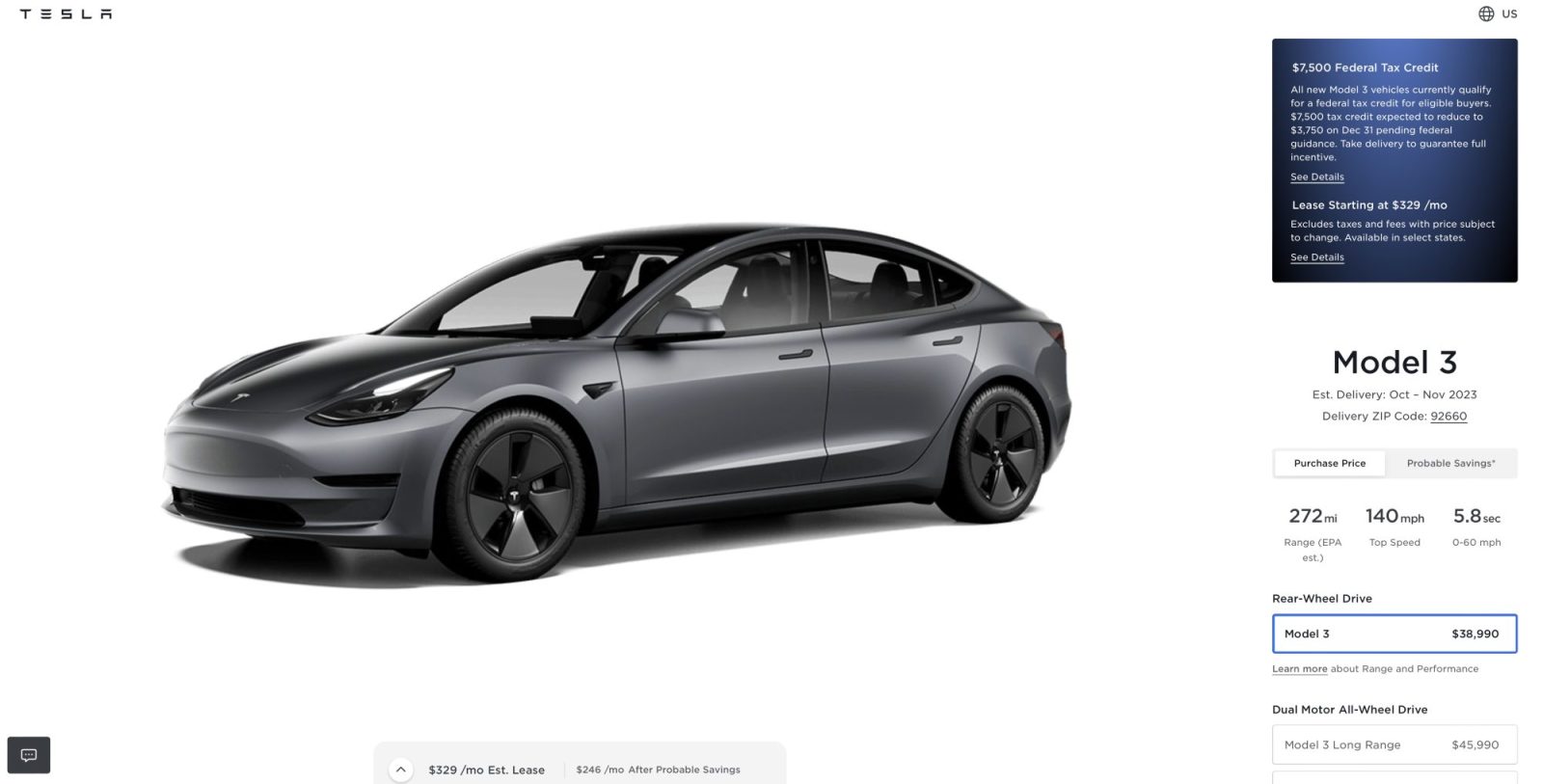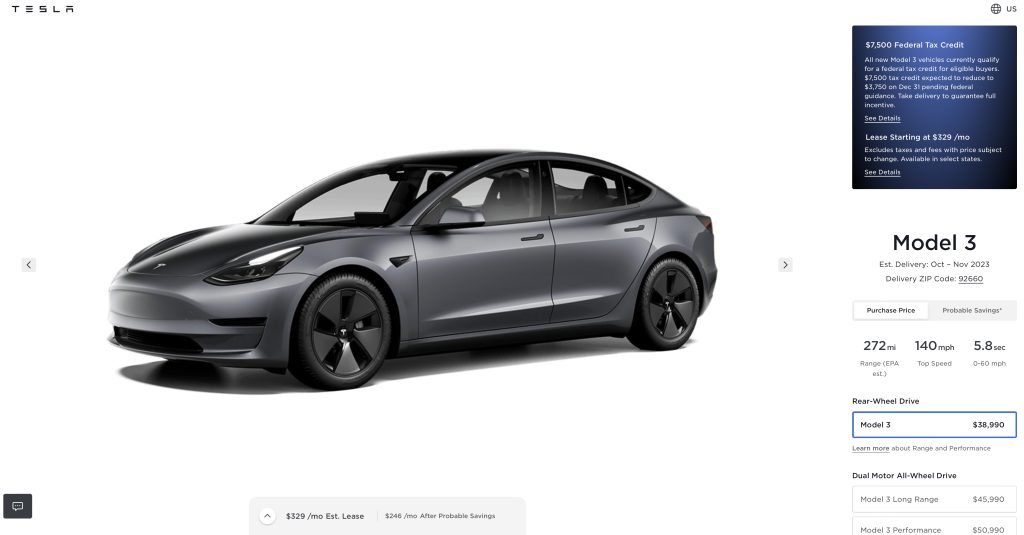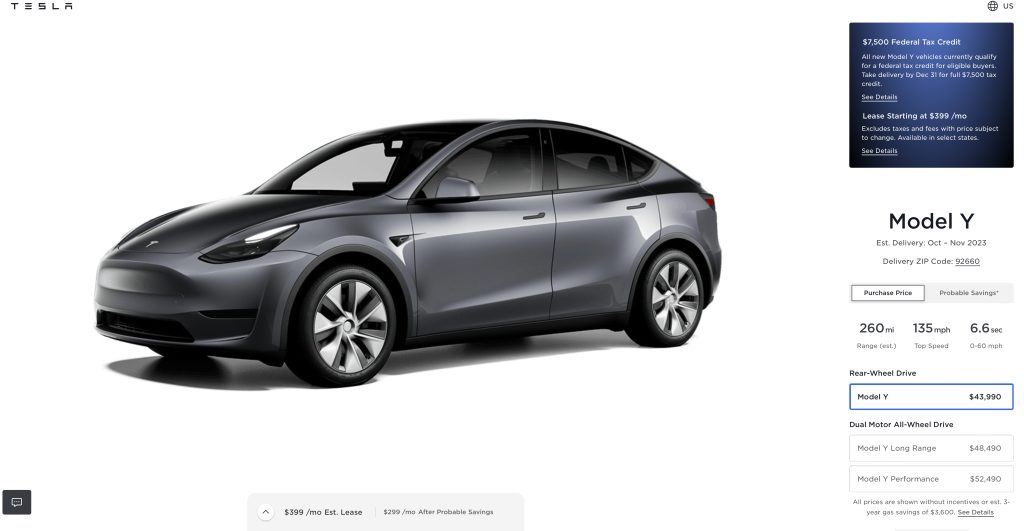
Hot on the heels of a price drop that makes the Model 3 the cheapest Tesla yet, Tesla has also cut the base lease pricing for Model 3 and Y by $90/month and $100/month respectively.
But the company also now says that it “expects” to lose access to half of the US $7,500 federal tax credit on the Model 3 at year’s end, reducing that credit down to $3,750.
Tesla has continued to cut its prices throughout this year, with Model 3 getting another $1,250-$2,250 cut just last week and Model Y LR and Performance trims getting a $2K price cut.
But those price cuts throughout the year didn’t really manifest in lease pricing. Tesla has never really focused on leasing, and lease prices have always been a bit higher on a Tesla than on similarly priced EVs. Last quarter, for example, only about 5% of Tesla’s sales were leased, which is far below the industry average.
But that might be changing with a significant price cut today for Tesla’s leased vehicles.
Last week, Tesla quoted a monthly payment of $419/month for the Model 3 and $499/month for the Model Y on each base model. But today we’re seeing payments of $329/month and $399/month respectively, with the same down payment ($4,500), term (36 months), and mileage (10k/yr) as the previous prices were quoted.
Other trims have seen similar reductions of $70-$90/month off.


Tesla has now placed leasing front-and-center on the Model 3 and Model Y order pages, with the right side of the screen featuring purchase price (or Tesla’s misleading “probable savings” price), and the bottom portion quoting lease pricing, where it used to simply show the purchase price again. It is also easier to access a calculator for leasing/financing options by clicking on that bottom portion.
While Tesla’s website doesn’t state this openly, this price drop could have something to do with the way the EV tax credit works, which allows almost all of its restrictions to be bypassed by leasing vehicles. Most companies have taken advantage of this and are now passing along these lease savings to customers, but Tesla never did.
Again, we don’t know if it’s starting to do this now and passing the savings along, or if it’s still keeping those credits for itself and this lease price reduction is just reflective of the falling prices of Tesla vehicles anyway.
Tesla ‘expects’ to lose half of US tax credit on Model 3
But now it also looks like Tesla expects prices to increase at the end of the year – well, effective prices anyway, given that it now “expects” that half of the tax credit is going away for the Model 3.
The reason for this is that the Inflation Reduction Act tax credits are limited to cars with battery components and raw materials that come from the US or from a free trade partner. The restriction gets stricter each year, and it looks like Tesla thinks it won’t qualify for half of the credit with next year’s tightening of restrictions.
Tesla’s Shanghai factory has been producing Model 3s and components for Model 3s for quite some time now, having produced its 2 millionth EV last month. Some of those components include LFP batteries that make their way into Tesla’s base model vehicles and are made in China, which could be the reason for the reduction.
Before today, Tesla’s website stated on the Model 3’s order page that “reductions are likely after Dec 31.” Other models had seen the same warning at times, but currently the Model Y does not have that warning, rather saying, “Take delivery by Dec 31 for full $7,500 tax credit.”


But today Tesla has changed that warning to say: “$7,500 tax credit expected to reduce to $3,750 on Dec 31 pending federal guidance. Take delivery to guarantee full incentive.” It doesn’t specify if this applies to all models, or just the base LFP model (but if that’s the case, then why does it not apply to the base Model Y?)
Tesla has had a confusing history with this portion of the tax credit in the past. At first, the base Model 3 did not qualify for the full $7,500 tax credit upon the IRS’s release of battery guidance, though only a month and a half afterward, Tesla surprised by gaining access to the full credit on the base Model 3. Soon after that, it added the “reductions likely” language to its website, which it has now upgraded to “expected” for the Model 3.
Other models no longer say “reductions likely” – Model Y states, “Take delivery by Dec 31 for full $7,500 tax credit,” but doesn’t include similar language about reductions being likely or expected.
All this talk about tax credits is complicated and may not apply to every buyer, since every buyer can’t necessarily take advantage of the full credit due to the current credit being nonrefundable. But that too is changing on January 1, 2024, when the tax credit will be available upfront at the point of sale, and will then allow lower-income buyers to gain the full credit even if they don’t have enough tax liability to do so, as the IRS confirmed last week.
Top comment by Indeed
Part of why Tesla's lease rates are so slow, in my opinion, is the no option to buy at the end of the lease. I would consider a lease, but I'd like to know that I had the option to buy the car at the end of the lease if I wanted to. I know for some people, that doesnt matter at all and they'll just lease a new car again, but for some, it does matter.
This might otherwise be a boon for some trying to take advantage of Tesla’s new lower prices, but with this “expected” halving of the tax credit on Tesla’s cheapest model, that news is somewhat bittersweet.
Electrek’s Take
That said, there’s always the chance that this language is just a play by Tesla to sell more cars. There are two potential reasons one might think this: First, Tesla just had a disappointing quarter and may be looking to boost sales. It seemed to know ahead of time that that quarter might be disappointing, too, given its craven limited-time FSD transfer scheme, which seemed targeted solely at boosting sales, rather than doing what’s right for customers who purchased a system several years ago that still doesn’t do what Tesla said it would do.
Second, Tesla just released the highly anticipated Model 3 Highland refresh in Europe, but that isn’t expected to come to the US until early next year. This could mean some buyers want to delay and purchase the new Model 3 with all the new features, but may be lured into buying early with Tesla dangling price drops and potential loss of tax credits in front of them.
Just like when Tesla originally added the “reductions likely” language, which we called “self-serving,” the vagueness of exactly why these credits were gained in the first place, and why they might be lost, makes it difficult to understand what the reason for the credit reduction is, and whether Tesla might just be yanking our chain. A little clarity on this would be nice from Tesla’s, uh… PR department…
FTC: We use income earning auto affiliate links. More.






Comments